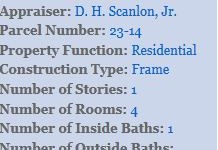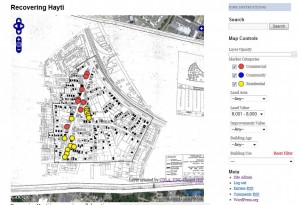We have just completed our first full demonstration project in our diPH prototype – “Recovering Hayti.”
Background
Recovering Hayti is an ongoing collaborative project being undertaken with Preservation Durham, a local historical preservation society whose mission “is to protect Durham’s historic assets through Action, Advocacy, and Education.” This demonstration project is an emulation of the “Repopulating Hayti” project (created in “Main Street, Carolina” or MSC), begun as a graduate student project in our Digital Humanities course (fall 2011) with contributions from students in our undergraduate “Main Street, Carolina” class. The project maps the lost community of Hayti, which was largely destroyed during the Urban Renewal efforts of the 1960s.
The Hayti neighborhood of Durham was a vibrant African-American community that flourished from the 1880s to the 1940s—one which W.E.B. DuBois held up as a shining example of black success. With its own thriving businesses and culture, Hayti was home to / or associated with many important institutions, including North Carolina Central University (NCCU), White Rock Baptist Church, and Lincoln Hospital. By 1960, the community was targeted for destruction during the process of Urban Renewal. Many homes and businesses were thus torn down to make way for the Durham Freeway (Highway 147). Very little remains of Hayti’s built environment today, though its legacy still persists.
This projects currently maps over 200 homes and businesses using the photos and parcel appraisals from the Durham Urban Renewal Records. These documents are part of the North Carolina Collection at the Durham County Library, and were digitized by the North Carolina Digital Heritage Center. The map, drawn in 1961, was created by City Planning and Architectural Associates of Chapel Hill. The Durham City-County Planning Department provided the digital version of the map.
Features
“Recovering Hayti” demonstrates many of the core features that will be included in diPH beta, including the following features that were part of the original MSC project:
- An interactive historical map layered over contemporary satellite imagery
- The ability to toggle between the historic and contemporary landscape by changing the level of transparency of the historical map layer
- Categorized and tagged historical content associated with (pinned to) the map layers. The categories dictate the color of the map pins, and the tags allow for refined searching.
- Hosting of multi-media content, including photographs, videos, and PDFs
We then added several enhancements to the project:

You can search on exact values of many custom fields pulled from the original parcel appraisal forms
A searchable database of custom fields pulled from the original parcel appraisal forms. Users can search approximately 22 fields, such as Property Owner, Land Value, Number of Stories, Number of Rooms, Number of Inside Baths, and whether properties had heating and electricity. This database adds significant power to the project, by allowing users to see similarities and differences in the neighborhood based on a set of features. The database searches on exact matches for values.
We manually entered the field values, but plan to explore ways that the data could be automatically extracted from the historical document and put into a database.
Enhanced map control buttons that allow searching on a range of values for different data fields, such as land value and building age. These values are useful for visualizing and understanding the extent of the “blight” that affected the area targeted for Urban Renewal.
Embedded contemporary Google Street View for easier comparison of the historic and contemporary landscape.
User-generated content (comments) providing an in-depth look at three buildings. These comments trace the history of the properties and their occupants by using Durham city directories, census data and other statistical/demographic data available from ancestry.com.
Embedded oral history audio about one of the properties (select the “oral history” tag from the Building Use drop-down menu on the right).
We focused a lot of our energy on enhancing the search and browse capabilities of the project for several reasons. For one, we wanted to create multiple entry points into the collection – through the map, through the database search function, and through the various map controls. Equally important to us, we wanted to harness the raw data in the historical collection for the purposes of sense-making. The traditional narrative of Hayti is that it became a “blighted” area by the 1950s, thus necessitating the need for urban renewal. Being able to actually search through the collection through a database interface allows us to get a better, more nuanced, understanding of the nature of “blight,” which may help us better understand the process of urban renewal in Durham more generally.
Stay tuned…
We are still working on a few features for this project, most notably a help mode that will demo the project’s various features. Users will be able to select the help mode when they first click on the project (a welcome message pops up in a lightbox when you first arrive), but they will be able to view the demo at any point by clicking on the diPH Instructions box.
One final note: you may notice a second project in our diPH prototype, an emulation of our Charlotte 1911 Project. Though the two projects are contained in the same installation of diPH, the data for each project, including the unique map controls, are isolated to each project. This means that you can create multiple disparate projects in one diPH interface!
Tell us what you think!
We encourage you to explore the project, play around with its features, and let us know what you think. You can comment directly on the site, or you can email us at digitalinnovation@unc.edu.


